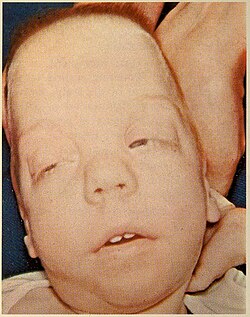Smith–Lemli–Opitz syndrome

Editor-In-Chief: Prab R Tumpati, MD
Obesity, Sleep & Internal medicine
Founder, WikiMD Wellnesspedia &
W8MD medical weight loss NYC and sleep center NYC
| Smith–Lemli–Opitz syndrome | |
|---|---|

| |
| Synonyms | SLOS, 7-dehydrocholesterol reductase deficiency |
| Pronounce | |
| Specialty | Medical genetics |
| Symptoms | Intellectual disability, behavioral problems, microcephaly, distinctive facial features, syndactyly |
| Complications | N/A |
| Onset | Prenatal |
| Duration | Lifelong |
| Types | N/A |
| Causes | Genetic mutation in the DHCR7 gene |
| Risks | |
| Diagnosis | Genetic testing, clinical evaluation |
| Differential diagnosis | Trisomy 18, Trisomy 13, Noonan syndrome |
| Prevention | |
| Treatment | Cholesterol supplementation, dietary management |
| Medication | |
| Prognosis | Variable, depends on severity |
| Frequency | 1 in 20,000 to 1 in 60,000 newborns |
| Deaths | |
Smith–Lemli–Opitz syndrome (SLOS) is a rare autosomal recessive genetic disorder characterized by multiple congenital anomalies and intellectual disability. It is caused by mutations in the DHCR7 gene, which encodes the enzyme 7-dehydrocholesterol reductase. This enzyme is crucial for the final step in the cholesterol biosynthesis pathway.
Signs and Symptoms[edit]
Individuals with Smith–Lemli–Opitz syndrome exhibit a wide range of symptoms, which can vary in severity. Common features include:
- Intellectual disability and developmental delays
- Distinctive facial features such as microcephaly, broad nasal bridge, and upturned nostrils
- Hypotonia (low muscle tone)
- Syndactyly (webbing) of the second and third toes
- Polydactyly (extra fingers or toes)
- Cleft palate
- Genital abnormalities in males, such as hypospadias or cryptorchidism
- Feeding difficulties and failure to thrive
- Behavioral problems, including autism spectrum disorder-like behaviors
Genetics[edit]
Smith–Lemli–Opitz syndrome is inherited in an autosomal recessive manner. This means that an affected individual must inherit two copies of the mutated DHCR7 gene, one from each parent. Carriers of a single mutated gene typically do not show symptoms of the disorder.
Pathophysiology[edit]
The DHCR7 gene mutation leads to a deficiency in the enzyme 7-dehydrocholesterol reductase, which is responsible for converting 7-dehydrocholesterol to cholesterol. As a result, individuals with SLOS have low levels of cholesterol and elevated levels of 7-dehydrocholesterol. Cholesterol is essential for normal embryonic development, cell membrane structure, and the synthesis of steroid hormones and bile acids.
Diagnosis[edit]
Diagnosis of Smith–Lemli–Opitz syndrome is based on clinical features and confirmed by biochemical testing showing elevated levels of 7-dehydrocholesterol in the blood. Genetic testing can identify mutations in the DHCR7 gene.
Treatment[edit]
There is no cure for Smith–Lemli–Opitz syndrome, and treatment is symptomatic and supportive. Management may include:
- Dietary supplementation with cholesterol
- Physical therapy and occupational therapy to address developmental delays and hypotonia
- Surgical interventions for congenital anomalies such as cleft palate or genital abnormalities
- Behavioral therapy and educational support for intellectual disability and behavioral issues
Prognosis[edit]
The prognosis for individuals with Smith–Lemli–Opitz syndrome varies depending on the severity of the condition. Early intervention and supportive care can improve the quality of life for affected individuals.
See also[edit]
- Autosomal recessive disorder
- Genetic disorder
- Cholesterol
- Developmental delay
- Intellectual disability
- Congenital anomaly

This article is a genetic disorder stub. You can help WikiMD by expanding it!
Ad. Transform your life with W8MD's Budget GLP-1 injections from $75


W8MD offers a medical weight loss program to lose weight in Philadelphia. Our physician-supervised medical weight loss provides:
- Weight loss injections in NYC (generic and brand names):
- Zepbound / Mounjaro, Wegovy / Ozempic, Saxenda
- Most insurances accepted or discounted self-pay rates. We will obtain insurance prior authorizations if needed.
- Generic GLP1 weight loss injections from $75 for the starting dose.
- Also offer prescription weight loss medications including Phentermine, Qsymia, Diethylpropion, Contrave etc.
NYC weight loss doctor appointmentsNYC weight loss doctor appointments
Start your NYC weight loss journey today at our NYC medical weight loss and Philadelphia medical weight loss clinics.
- Call 718-946-5500 to lose weight in NYC or for medical weight loss in Philadelphia 215-676-2334.
- Tags:NYC medical weight loss, Philadelphia lose weight Zepbound NYC, Budget GLP1 weight loss injections, Wegovy Philadelphia, Wegovy NYC, Philadelphia medical weight loss, Brookly weight loss and Wegovy NYC
|
WikiMD's Wellness Encyclopedia |
| Let Food Be Thy Medicine Medicine Thy Food - Hippocrates |
Medical Disclaimer: WikiMD is not a substitute for professional medical advice. The information on WikiMD is provided as an information resource only, may be incorrect, outdated or misleading, and is not to be used or relied on for any diagnostic or treatment purposes. Please consult your health care provider before making any healthcare decisions or for guidance about a specific medical condition. WikiMD expressly disclaims responsibility, and shall have no liability, for any damages, loss, injury, or liability whatsoever suffered as a result of your reliance on the information contained in this site. By visiting this site you agree to the foregoing terms and conditions, which may from time to time be changed or supplemented by WikiMD. If you do not agree to the foregoing terms and conditions, you should not enter or use this site. See full disclaimer.
Credits:Most images are courtesy of Wikimedia commons, and templates, categories Wikipedia, licensed under CC BY SA or similar.
Translate this page: - East Asian
中文,
日本,
한국어,
South Asian
हिन्दी,
தமிழ்,
తెలుగు,
Urdu,
ಕನ್ನಡ,
Southeast Asian
Indonesian,
Vietnamese,
Thai,
မြန်မာဘာသာ,
বাংলা
European
español,
Deutsch,
français,
Greek,
português do Brasil,
polski,
română,
русский,
Nederlands,
norsk,
svenska,
suomi,
Italian
Middle Eastern & African
عربى,
Turkish,
Persian,
Hebrew,
Afrikaans,
isiZulu,
Kiswahili,
Other
Bulgarian,
Hungarian,
Czech,
Swedish,
മലയാളം,
मराठी,
ਪੰਜਾਬੀ,
ગુજરાતી,
Portuguese,
Ukrainian
